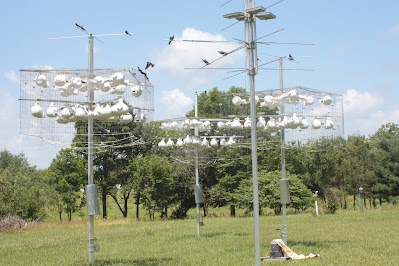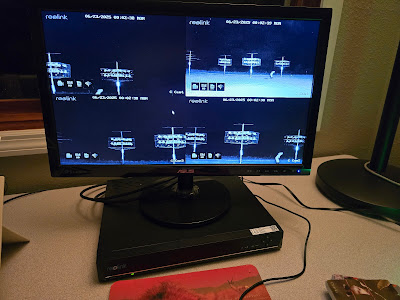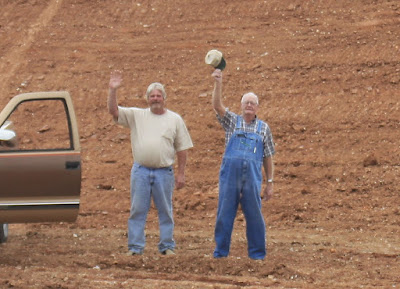A few weeks ago, I received a message from a long-time purple martin friend - I'll call her "Jane" to protect her privacy. She informed me that she had been diagnosed with pancreatic cancer and only had about 2 months left to wander this mortal coil. While my shock was nowhere near what hers must have been, I was still stunned. She's only about 10 years older than me and the medical community had failed in her initial diagnosis. But her request was even more surprising.
Jane and I had never met in person, but we had spoken on the phone several times over the last few years about our shared experiences with owl issues and messaged each other on Facebook....replied to each other's comments about purple martins, etc. So, I felt like I *knew* her already we had become friends through our interactions. Her request - she wanted me to come and remove all her purple martin and bluebird housing - all of it - for free - and give it to a good home.
 |
| Note, this is a picture of my Troyer Super system gourd rack |
I've never received a call like that one, so I had no frame of reference on how to react or deal with this type of request. "Of course", I replied, "I'll help in any way I can". She wanted me to come dismantle everything and haul it away as soon as I could, so that her husband wouldn't have to deal with it after her death. My brain felt like it had a very loud pinball machine going at full speed inside my skull. "But, OMG, it's 100 degrees outside!", my brain screamed. Ping! Then, "OMG, she's dying and I need her to know that I fulfilled her last wishes". I contacted my neighbor to confirm that he wanted the equipment since he had shown interest in setting up a gourd rack this summer. He confirmed that he wanted it and would help me / her with whatever was required. We confirmed a date (last Saturday).
She sent me another message within a week and told me she was declining fast and almost bedridden and gave me her husband's phone number, in case she was gone by the time we could get there. I called him and he told me, "it's going to be so hot that day". I offered to come at a later date when it was cooler and he said, "no, I need it all gone".
Ping, ping, PING. Finally resolving myself that we could just take frequent breaks and take it slow, we (my husband, neighbor & myself) figured out what tools we would need to dismantle everything and got up early Saturday to make the 2.5 hour trip to her house. When we arrived, it was already 90 degrees outside and blazing hot sun was beating down on us. My neighbor had brought his 16' trailer pulled by his pickup. Jane's husband, "John" walked over & introduced himself. As we previewed everything, he made comments as to the modifications she had made to her housing, the owl fencing, etc., and said, "she did a lot of this based on your recommendations". Ping....
We were stunned at the amount of bluebird houses (14) with poles & predator guards, and even more stunned by the quality (and quantity) of her purple martin systems - 1 Gemini and 1 Troyer Super System gourd rack, plus 4 other Troyer gourd rack systems (2") square poles and the pile of already-cleaned-out horizontal & vertical Troyer and S&K gourds. And 3 modified Trio aluminum houses. Every pole had a predator guard, snake netting. A wide variety of traps, including the Blaine's elevator trap. ReoLink cameras - new, not even removed from their packaging yet. Three storage bins marked, "PM stuff". A box with her handwritten note, "Trail Cameras - Kathy Freeze". Ping...my heart ached seeing her own handwriting. The heat wasn't helping.
I started trying to figure out where to start first. Luckily, my husband led the charge. He grabbed some wire cutters and went to the closest purple martin gourd rack and started clipping the zip ties that secured the fencing to her racks. Bazillions of zip ties....yes, bazillions. I told her husband, "they call me the Queen of Zip Ties on the purple martin forums, but now I see - I don't hold a candle to Jane...holy cow!". A little levity in a very sad setting. All 3 of us clipped & clipped and finally got rack #1 down. Moving on to rack #2. The sun felt like it was going to burn through my skin. My neighbor whispered to me, "this is a LOT more than I expected". Yeah, me too - all of it was overwhelming. Every bit of it....the sadness of the situation, the look in her husband's eyes, along with his soft demeanor as he told me, "This was her passion - she was out here all the time working with her birds". And I suddenly realized just how much she and I were really alike. Ping...
 |
| 2 of the 14 bluebird houses |
John told me she was bedridden now and wouldn't last much longer. Ping.. and here I was dismantling her passion just outside her front door....struggling with the extreme emotions of being happy that my neighbor was the beneficiary of such great, well-cared-for, quality equipment, proud that she had selected me to be the recipient to distribute the stuff, yet, so sad that these were the circumstances under which it had occurred. Adding to that, my thoughts turned to what would happen to my 'stuff' if this someday happened to me. I laughed (to myself) about how many zip ties someone would have to cut off my wire cages (a lot less than we cut off that day!!), how organized my stuff would be to pass on to someone else - (would it be stored in such nice bins?)...and started thinking about all the little odds & ends that someone would look at some day and wonder for what purpose I was keeping that broken piece of whatever.
 |
| Purple martin fledges |
John thanked us for taking it all down and hauling it away and their yard looked so barren as we left. I am still very emotional about all of this....because it has made me think of my own mortality and what happens in the aftermath of a landlord's passing. In the meantime, I'll try to be more strategic with my zip tie usage and not keep so many broken pieces & parts for, "just-in-case". Ping






















.JPG)

































